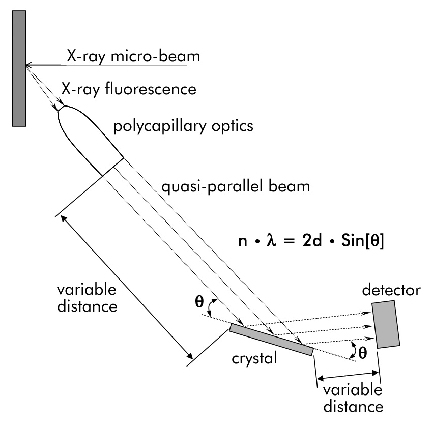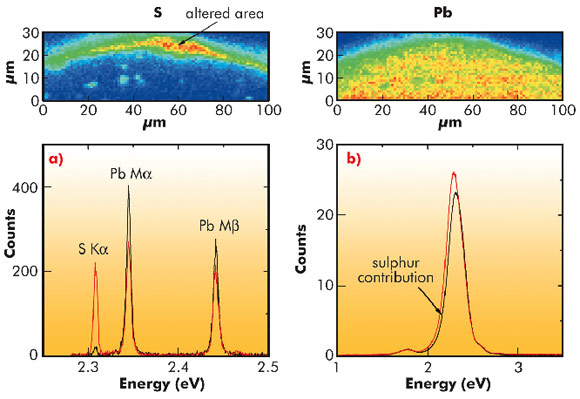- Home
- Users & Science
- Scientific Documentation
- ESRF Highlights
- ESRF Highlights 2010
- X-ray imaging
- Wavelength-dispersive spectrometer for X-ray micro-fluorescence analysis
Wavelength-dispersive spectrometer for X-ray micro-fluorescence analysis
Beamline ID21 is dedicated to micro-X-ray fluorescence (µXRF) and micro X-ray absorption spectroscopy (µ-XANES) in the X-ray energy domain between 2 keV and 9 keV. The scanning X-ray microscope enables the localisation and speciation of trace elements down to the ppm range with a submicrometre beam size. It provides access to the absorption edges of a wide range of elements of interest in the areas of Environmental Sciences, Earth and Planetary Sciences, Life Sciences and Cultural Heritage [1]. The beamline relies on several solid-state detectors, which are complementary in terms of count rate throughput and solid angle collection efficiency. However, the attainable energy resolution (120-180 eV) of such energy dispersive detectors is often inadequate to permit unequivocal elemental and chemical speciation. To improve the energy resolution of fluorescence detection of the X-ray microscope, a wavelength dispersive spectrometer has been developed.
Since 1912, when the Bragg law was formulated [2], wavelength dispersive spectroscopy has become one of the most important tools in X-ray fluorescence analysis. In contrast to energy dispersive detectors, wavelength-dispersive spectrometers (WDS) can provide a much better energy resolution of the detected X-rays. Their X-ray detection takes place through the diffraction process on the crystal. The spectrometer can be based on a flat or curved crystal geometry that has to be adapted to the particular experimental setup. The geometry of the WDS configuration is shown in Figure 137. It uses a polycapillary optics placed at a distance of a few millimetres from the sample. This optics converts the divergent X-ray fluorescence emitted from the sample into a quasi-parallel beam, which is then directed onto the flat crystal at the required Bragg theta angle. The X-rays diffracted by the crystal are counted by a detector placed at the 2-theta angle. The polycapillary-based-WDS configuration results in a simple alignment of both crystal and detector. Moreover, the distances polycapillary-to-crystal and crystal-to-detector are not critical and thus can be easily adapted to specific experimental constraints. This arrangement also permits a very compact geometry, a necessary prerequisite for the installation of a high-resolution X-ray micro-fluorescence analysis system at the ID21 beamline.
 |
|
Fig. 137: Schematic drawing of the parallel beam wavelength-dispersive arrangement employing polycapillary optics for X-ray fluorescence collection. |
The newly developed spectrometer was applied to study historical samples such as ancient glasses and paintings. For such samples, not only spectral resolution was necessary but also spatial resolution as the pigments and opacifiers are usually present as micrometric particles dispersed in a matrix. Accordingly, a sub-micrometric probe is crucial to selectively probe the different constituents. This point is illustrated in the following example whose objective was to identify the composition of a brown alteration spreading on the surface of a painting entitled “Bateaux de Pêche”, executed by J.A. Noel in 1867 and conserved in the Musée de Picardie, Amiens, France. A sample fragment was taken in an altered area and prepared as a cross-section to reveal its entire stratigraphy. The altered brown layer was only 5 µm over the original blue layer, and the main composition of both layers was lead. The X-ray fluorescence spectra measured with a solid-state detector showed very small differences between the two layers. In the broad unresolved Pb M-emission lines only a shoulder on the low energy side could be seen (Figure 138b). When acquiring the X-ray fluorescence spectra with the WDS, this shoulder can be unequivocally shown to contain the sulphur Kα emission lines (Figure 138a). The energy resolution of the spectrometer was crucial in this case to establish the presence of sulphur in the brown layer. Spatial micro-mapping of sulphur and lead show that they are both present in the brown layer, while sulphur was absent in the original blue layer (Figure 138, top panels). Lead sulphates were subsequently identified using µXANES. This analysis showed that the brown alteration observed on the surface of the painting may have resulted from the reaction of the original lead white pigment with exogenous SO2.
Many other complex materials from the Cultural Heritage field will probably benefit from the new capabilities offered by the ID21 WDS.
Principal publication and authors
J. Szlachetko (a,b,c), M. Cotte (a,d), J. Morse (a), M. Salomé (a), P. Jagodzinski (e), J.-Cl. Dousse (f), J. Hoszowska (f), Y. Kayser (f) and J. Susini (a), J. Sync. Rad. 17, 400-408 (2010).
(a) ESRF
(b) Institute of Physics, Jan Kochanowski University, Kielce (Poland)
(c) currently at: Paul Scherrer Institut, Swiss Light Source (Switzerland)
(d) Centre of Research and Restoration of French Museums, UMR171, Paris (France)
(e) Technology University, Kielce (Poland)
(f) Department of Physics, University of Fribourg (Switzerland)
References
[1] J. Susini, M. Salome, B. Fayard, R. Ortega and B. Kaulich, Surf. Rev. Lett. 9, 203- 211 (2002).
[2] W.H. Bragg and W.L. Bragg, Proceedings of the Royal Society of London, Series A 88, 428-438 (1913).




